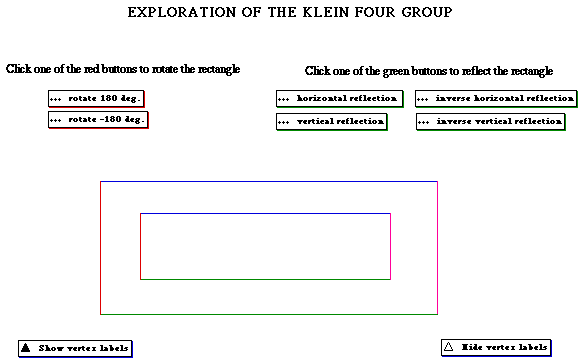


Introduction to the theory of groups is often a traumatic experience for students. This theoretical student of abstract objects can discourage even the most motivated mathematics student. Due to the visual nature of geometric objects and students familiarity with them introducing groups as the reflections and rotations of these familiar objects is logical. Dr. Ed Dubinsky, professor of Mathematics at Georgia State University, validates the necessity for visualization as a logical starting point for developing student's analytical knowledge of group structutres and elemental properties in his article "Coordinating Visual and Analytical Strategies: A Study of Students' Understanding of the group D4." Often students are encouraged to build models to explore the elements of the groups produced by the rotations and reflections of geometric objects. This is a fine exercise except that for some students the cognitive load created in short term memory when the geometric objects original position must be held in memory and compared to the translated object is simply too great. This cognitive overload results in frustration, repeated trials, and ocassional failure. So for investigation of a group, its elements, the effect of its action by left multipliction or conjugation on the vertices, the effect of its action by left multiplication or conjugation on itself, the conjugacy classes, the normalizer of a subgroup, the normalizer of an element, the center of the group, and the development of a Caley table Geometer's Sketchpad can be used to reduce the cognitive load. Students can manipulate geometric objects while the original position is marked by a copy of the object.
Using Geometer's Sketchpad, a movable rectangle can be constructed that student's can use to investigate the ideas outlined above. The model I have developed so far, with the help of Dr. Jim Wilson, Chris Drumm, Laura Dickerson, and Patricia Johnson can be viewed by clicking HERE. An image of the current page follows.

Often one of the first investigations done with the elements of a group is to determine the Caley Table. Recall that the Caley Table is a chart having the group elements listed across the top row and the left hand column of the table. The entry in the ith row and the jth column of the table represent the group elements that result as the ith entry on the left acts on the jth entry on the top.
To produce a Caley table for the Klein Four Group use the following table, where i = identity, R = rotation by 180 degrees, H = horizontal relection, and V = vertical reflection, and the Klein Four GSP Sketch to compute the table.
Click HERE to return to the GSP Sketch for the Klein Four Explorations
|
Klein Four |
i |
R |
H |
V |
|
i |
||||
|
R |
||||
|
H |
||||
|
V |
To see if your answer is correct click HERE.
It is fairly easy to see from looking at the Caley table what the inverses of the elements are and which elements are in the center of the group. Recall that elements in the center of the group commute with all the elements in the group.
If we let the group of rotations and relections of a rectangle act on the vertices of the rectangle and we number the vertices, we can find the group of permutations of the vertices that correspond to the motion of the rectangle.
Recall that if vertex 1 moves to vertex 2 and vertex 2 moves to vertex 1, while vertex 4 moves to vertex 3 and 3 moves to four we would have the resulting permutation (1 2) (3 4). If vertex 1 moves to vertex 2, vertex 2 moves to vertex 3, vertex 3 moves to vertex 4, and vertex four moves to vertex 1 then we have the permutation (1 2 3 4).
See if you can write out the permutation corresponding to the action of the group on its vertices.
|
Motion |
Corresponding Permutation |
|
i |
|
|
R |
|
|
H |
|
|
V |
Click HERE to return to the GSP Sketch for the Klein Four Explorations.
Click HERE to see the solutions for the Permutations.